According to statistics, almost half of all visits to the dermatologist are in one way or another related to fungal diseases. You can catch an infection by visiting a swimming pool, sauna, beach, or walking around in your host's slippers. Learn all about how to identify toenail fungus without scraping or using other diagnostic methods - symptoms of onychomycosis in the initial and chronic stages of the disease.
What is toenail fungus?
Yeast fungi
They rank second in the frequency of occurrence of foot mycoses. The disease is caused by two types of pathogens of the genus Candida:
- White Candida (Candida albicans) – occurs most commonly on the fingers, as a complication of existing onychomycosis caused by dermatophytes.
- Parapsilosis (Candida parapsilosis) – affects the nail plate from the edge. The first symptoms are characterized by the appearance of black spots on the fingertip, which gradually become larger. Candida parapsilosis often leads to complete destruction of the nail plate.
Mold
This type of fungal infection is not particularly common - only three patients who saw a dermatologist suffered from it. There are different types of mold pathogens:
- Scopulariopsis – often affects large toes that have been previously injured.
- Aspergillus or black mold – infection with onychomycosis is possible only in people with reduced immunity. The main symptom of the disease is deformation of the nail plates and the appearance of normotrophic blackheads.
- Fusarium – this onychomycosis is very rare because the pathogens live on agricultural crops. Infection of a person is possible only if there are open wounds, abrasions or cracks on the legs.
Dermatophytes
The priority among the pathogens of onychomycosis is taken by dermatophytes, which most often affect the feet:
- Red Trichophyton (Trichophyton rubrum) – develops on the lateral and distal surfaces. The main symptoms at the initial stage of development are yellow spots or white stripes. Without specific treatment, fungal spores can spread throughout the body and cause serious skin lesions.
- Mentagrophytes (Trichophyton mentagrophytes) – cracks appear in the interdigital spaces, severe pain when moving. Without appropriate treatment, it spreads to the nails; the fungus can particularly often affect the thumb and little finger.
- Epidermophyton floccosum – attacks the skin of the fingers in the early stages. Toenail fungus manifests itself as peeling of the feet, accompanied by itching and increased sweating of the fingers. Without treatment, Epidermophyton leads to atrophy.
What does toenail fungus look like?
Today, two classifications of onychomycosis are used in medicine: the first – according to the nature of pathological changes and the second – depending on the localization. Based on the type of fungal infection, all species are divided into four subtypes: marginal, normotropic, hypertrophic and atrophic. Depending on the form of localization, there are several more types of diseases:
- distal – when only the edge suffers from the fungus;
- lateral - pathological processes begin near the skin ridges;
- proximal – the change affects the lower part;
- white superficial onychomycosis – white spots or streaks appear.
Regional onychomycosis
This is the initial stage of the fungus and is very difficult to identify on your own. This type of mycosis is accompanied by changes on the edge of the nail plate, which are visible by the appearance of narrow gray stripes. Over time, the symptoms of toenail fungus increase: the color begins to fade, brittleness appears, while the thickness of the nail plate remains the same. Grayish-yellow spots may sometimes appear.
Normotrophic
This type of onychomycosis is manifested by a decrease in shine, but maintaining the thickness of the hard part of the finger. The main symptoms of the normotrophic type are:
- increased fragility;
- loss of shine;
- the appearance of white or grayish-yellow spots on the entire surface of the nail;
- the bed is visually divided into sectors;
- Gradually, gray mucus appears from under the nail.
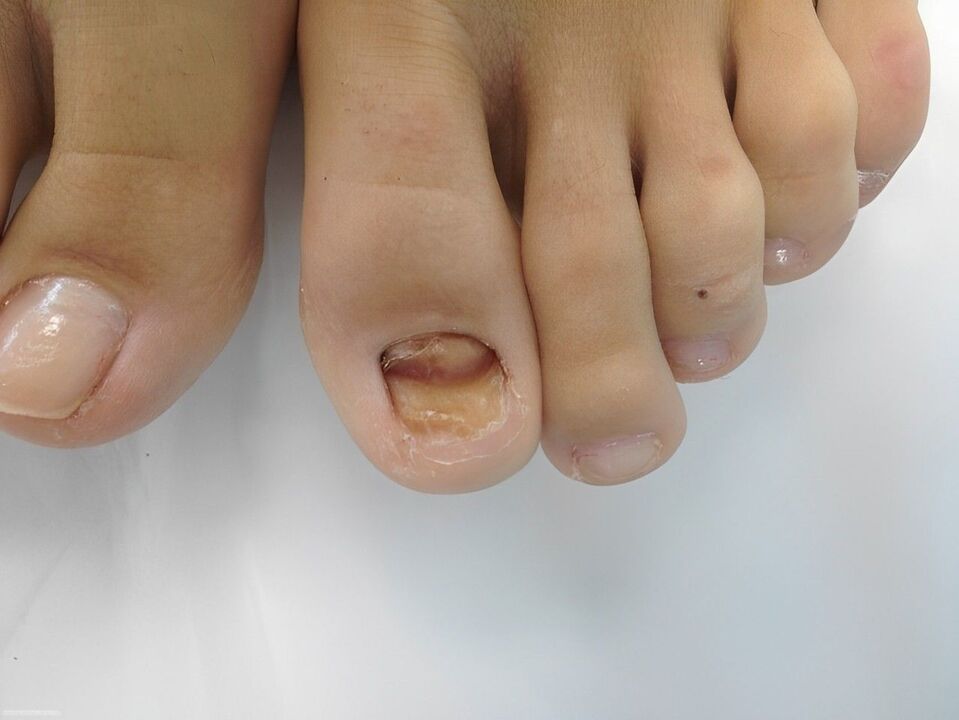
Hypertrophic
This has a specific symptom – the formation of atrophy at the edge. Hypertrophy leads to thickening of the nail plate and the appearance of an atypical pattern. Patients often complain of pain, especially when walking, which only goes away when they take painkillers. Hypertrophic mycosis consists of three stages:
- Overall – a massive lesion that affects the thickness of the nail plate.
- Side – appears on the side panels.
- Distal – the infection is localized under the free part of the bed.
White surface shape
This type of fungal infection is characterized by the appearance of small, white or almost white foci of infection in the center or edge of the nails. This type of onychomycosis only occurs on the legs. Due to the fact that the spores affect only the upper part of the finger, the plate itself is very rarely deformed, however, its upper layers and the epidermis suffer from the fungus. If left untreated, the hard part becomes loose and rough. As a rule, superficial onychomycosis is caused by dermatophytes.
Onycholytic
Accompanied by the detachment of part of the plate from the soft nail bed. The affected nail becomes dull, has gray spots and gradually loses its shine. As a rule, this type of fungus manifests itself as a complication of hypertrophic or normotrophic mycosis. Without appropriate treatment, areas covered with hyperkeratosis may appear at the lesion site.
Candida onychomycosis
Often associated with damage to healthy periungual tissue. The pathology usually occurs on the 3rd or 4th finger or toe. Candida mycosis is characterized by the following symptoms:
- lack of skin on the nail growth line;
- fragility and crumbling of the edges of the plates;
- the appearance of transverse stripes at the bottom of the bed;
- inflammation of skin folds;
- brownish-brown color of the nail plate;
- Soft tissue pain.
Proximal deformation
One of the rarest forms of onychomycosis. The disease often begins to develop from soft tissue and gradually migrates to a healthy nail. Fungal growth begins in the middle of the nail. Without treatment, the plates change color, begin to crumble and peel off. The causative agents of the proximal-deforming form are: red trichophyton and mentagrophytes.
Atrophic
This form of the unpleasant disease is characterized by a change from normal color to brownish-gray. In this case, the symptoms appear gradually: first the plate loses its shine and becomes dull, then the nail is destroyed and loose accumulations of small scales of skin are visible at the site of the bed. Pathological processes begin in the external part and eventually cover the growth zone and skin fold.
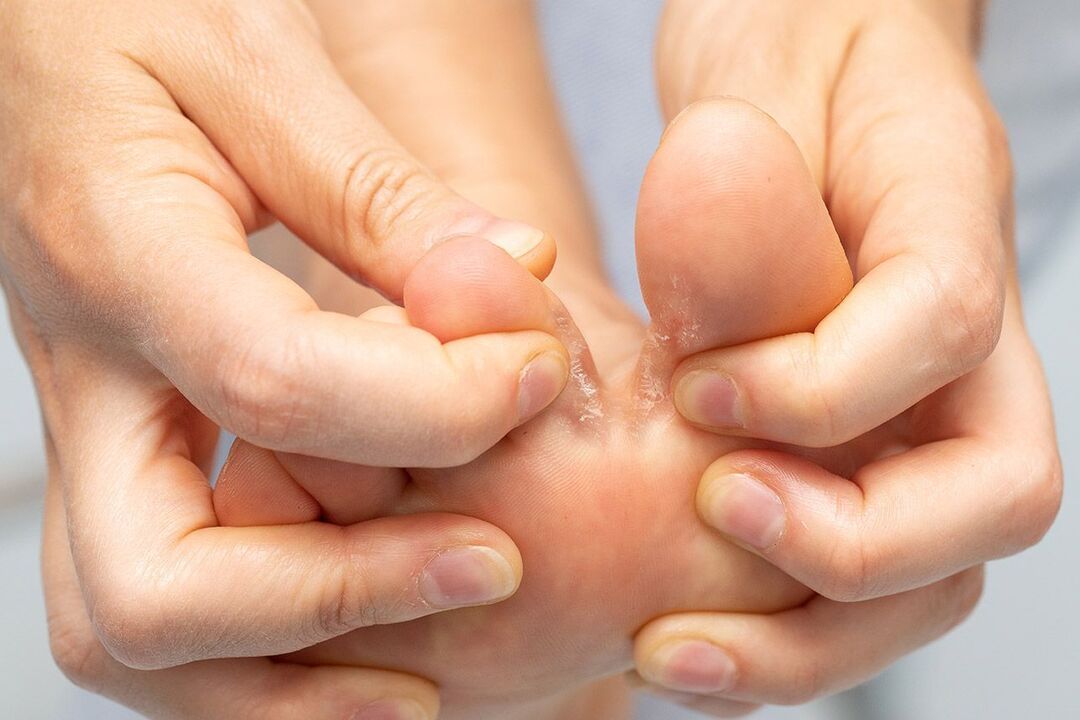
Types and stages of fungal infection
The signs of a fungal infection depend on the form of the disease and its severity. The first signs of pathology may not be noticed, but already to an average extent the plate is noticeably deformed, becomes thick and has a heterogeneous structure. Such signs cannot be ignored, since the next stage is dystrophic, the nail can collapse completely, inflammatory processes begin in the periungual groin, and secondary infection occurs.
Main forms of the disease:
- Lateral onychomycosis is the most common type of fungus. The first signs of fungus appear on the free edge of the nail in the form of a small yellowish spot. As the disease progresses, the plate thickens, deep cracks may form, and difficulty walking occurs. This form of fungal pathology is difficult to treat.
- White superficial onychomycosis – pathogenic microorganisms affect only the upper layers of the nail. The plate does not thicken, but over time it becomes loose and resembles chalk in structure. The treatment is not difficult and an improvement in well-being occurs quickly.
- Subungual onychomycosis is a rare form of pathology. Fungal symptoms appear in the form of thickening of the skin in the nail fold area, the nail becomes completely white and opaque.
There are a number of diseases that have symptoms similar to a fungal infection - psoriasis, eczema, lichen planus. Changes in the structure of the nail occur after injuries or bruises. Only a doctor can make an accurate diagnosis after a thorough diagnosis.
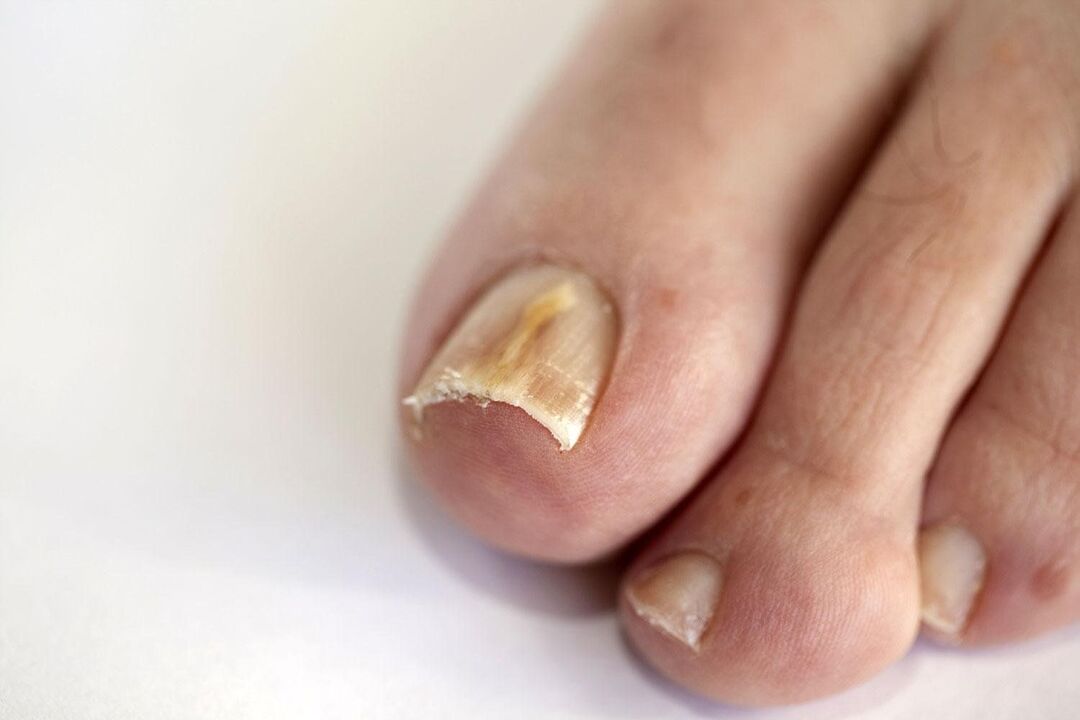
How to recognize a fungus on your toenails – common symptoms
Depending on the stage of the disease, a distinction is made between complete atrophy and partial hypertrophy; both concepts are related to each other but are not synonymous. The atrophic type refers to impaired growth, thinning and complete destruction of the nail plate - this is the stage of total damage. When the dermatologist detects an advanced stage, patients often complain not only about changes in the structure, but also about severe pain.
Hypertrophic toenail fungus – symptoms:
- acquires a yellow tint at the edge of the plate or whitish inclusions appear near the growth zone;
- deformed – waves, tubercles and other irregularities appear;
- the pad turns red, peels, and swells as the infection increases;
- begins to peel off, moves away from bed;
- Small cracks and sometimes blisters appear between the fingers.
Itching and burning
The disease on the legs very often manifests itself in the form of severe itching. This feeling begins to bother the patient in the first few days after infection. When fungal spores attack the plate, itching is felt in the affected area, while the skin becomes flabby, dry and peeling, and irritation occurs. If the infection comes from soft tissues, the fingers themselves itch. If the skin is scratched severely, the itching is followed by a burning sensation. As a rule, these symptoms occur with lesions of the feet, less often with onychomycosis of the hands.
Loss of natural color
This is the next symptom of onychomycosis that replaces or complements itching. In this case, the color depends on the type of pathogen that has settled in the human body:
Once the fungal spores are in the fingers, they begin to actively multiply and gradually cover the entire space, slowly leading to complete deformation and destruction of the hard part. The plate becomes thicker or, conversely, very thin, begins to crumble and an unnatural yellow color and a whitish coating become noticeable. At the initial stage of infection, the structure of the nail plate itself changes - it becomes lumpy or covered with stripes, and the shade of the plate becomes cloudy.
Doctors distinguish three main stages of a fungal infection:
- The color turns yellow and furrows form. If you try to cut off the edge, the tip will begin to crumble. Sometimes an unpleasant smell may occur.
- The finger completely changed color, became dull and cloudy, and strange inclusions appeared. The yellowing begins to darken, black streaks appear, and green areas may appear. Clipping affected nails becomes very difficult.
- The entire nail has changed - it has become significantly thicker and it is no longer possible to trim the edge without softening it.
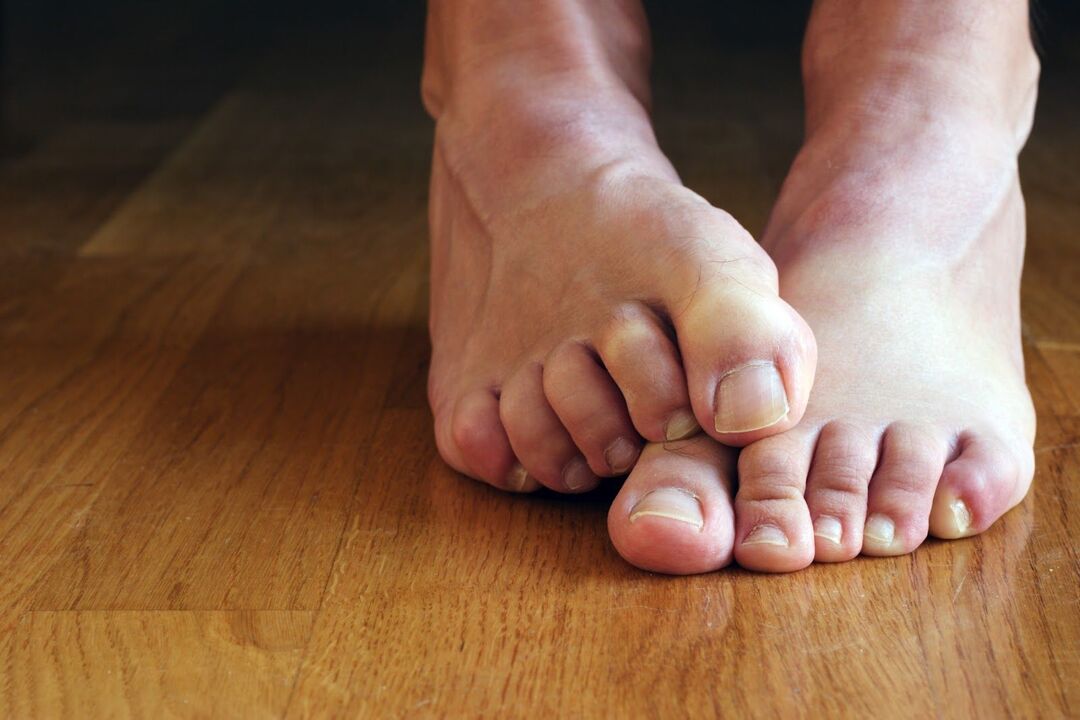
Pain in the nail area
Nail fungus symptoms are not typical for every patient. Some patients may not experience such symptoms at all, especially if the disease was detected at an early stage. With an advanced form of fungal infection, the pathology is easy to recognize: the fingers lose their original appearance, begin to flake and peel. At this stage, some patients may experience pain under the nail or in the fingers.
Painful sensations with mycosis of the toes can occur for several reasons:
- This causes the affected areas to become thicker, lose their original appearance and become deformed. In this case, even the most worn shoes cause noticeable discomfort when walking. This means that pain can be annoying not only when walking, but also after taking off your shoes.
- As the spores spread, the fungus conquers more and more new areas. When it gets into the soft nail tissue, the infection often affects the nerve endings, causing aching, paroxysmal, or throbbing pain. If a symptom occurs for this reason, symptoms can occur even when at rest.
- One of the signs of athlete's foot is the appearance of small cracks and blisters between the toes. The skin may become very red and inflamed and the fingers may swell. Due to the fact that the area between the toes sweats a lot in closed shoes, such wounds on the feet heal very slowly and hurt constantly.
How does toenail fungus develop?
Loss and change of color, the appearance of unevenness, thinning or thickening of the plate, delamination - these are the first signs of toenail fungus that correspond to the general description. However, with careful self-diagnosis, the disease can even be classified. E. g. :
- Infection with dermatophytes begins at the free edge of the plate. The appearance of a fungus is indicated by a small yellow spot and a crumbling surface.
- Yeast fungi are characterized by a proximal form - when the infection begins at the base. The main symptom of onychomycosis of the candidiasis type is inflammation of the periungual fold, detachment of the cuticle and pain when pressed.
- Mold causes fingers to turn green, brown or black. Mold infestation appears as spots, small dots or elongated plaques.
The first signs that you have toenail fungus are the symptoms that appear on the adjacent soft tissues. The skin of the feet loses its natural color, becomes red or yellow, becomes thin and is easily injured. As a rule, the fungal process begins here. Over time, the disease can cause serious inconvenience and provoke the appearance of deep cracks, itching and blisters with fluid.
Symptoms of a fungal nail infection
In the initial stages of infection, toenail fungus is almost invisible and does not cause any discomfort (see photo). Then characteristic symptoms of a fungal infection appear:
- the surface of the nail plate on the toes acquires an unpleasant cloudy color;
- the nail plate begins to peel off and separates from the nail bed;
- the diseased nail loses its original shape, becomes thicker and looks unkempt;
- Cracks gradually form between the toes; the person begins to feel pain in the area of the damaged nail;
- the skin on the toes begins to peel off;
- Itchy skin develops between the toes.
Nail fungus needs to be treated, preferably in the early stages. In this case, you can only use external preparations: ointments, varnishes and folk remedies. In a more advanced form, you need to take antifungal tablets. In this case, you will not be able to quickly get rid of the fungus on your feet.
What is dangerous about untreated onychomycosis?
In addition to the unpleasant external manifestations of this disease, the fungus is a pathogenic microorganism that causes damage to the entire human body:
- Untreated nail fungus opens the door to other infections.
- In addition, the fungus can act as an allergen and ultimately cause hypersensitivity to nail fungus as an allergen.
- Onychomycosis complicates the progression of many diseases, such as diabetes.
- In particularly severe cases, against the background of a long course of the disease or reduced immunity, a fungal infection can cause deep mycosis - the penetration of the fungus into the internal organs through the blood.
To avoid complications, you need to start treatment quickly when you notice the first signs of a nail fungal infection.
How to get rid of fungus on toenails?
Medicines used to treat nail fungus are divided into two groups.
- The first group is local influence opportunities. This group includes medical varnishes and peel-off plasters, ointments and creams as well as gels. The majority of medications for external use are effective only in the initial stages of the disease.
- The second group consists of systemic antifungals that are taken orally. These are usually capsules or tablets that have an inhibitory effect on the fungus. They block the spread of mycoses and have a prolonged effect, significantly reducing the possibility of a recurrence of the disease.
But considering that the drugs used to treat onychomycosis are highly toxic and often cause side effects, and the clinical picture of fungal infections of the skin and nail plate on the toes is always strictly individual, it is best to have an answer to theQuestion to give The question of how to cure the fungus on the feet of an experienced specialist.
Laser therapy
If the advanced form of the fungus cannot be treated with medication, laser therapy can be resorted to.
- Laser treatment of fungus is considered one of the most effective methods of getting rid of this disease.
- Under the influence of the beam, the fungal cells die immediately.
- The laser beam does not damage the surrounding tissue.
- An advanced form of the fungus can be cured in just four laser therapy procedures.
If you have decided to undergo laser treatment, it is also important to take all the necessary pills and vitamins at the same time.
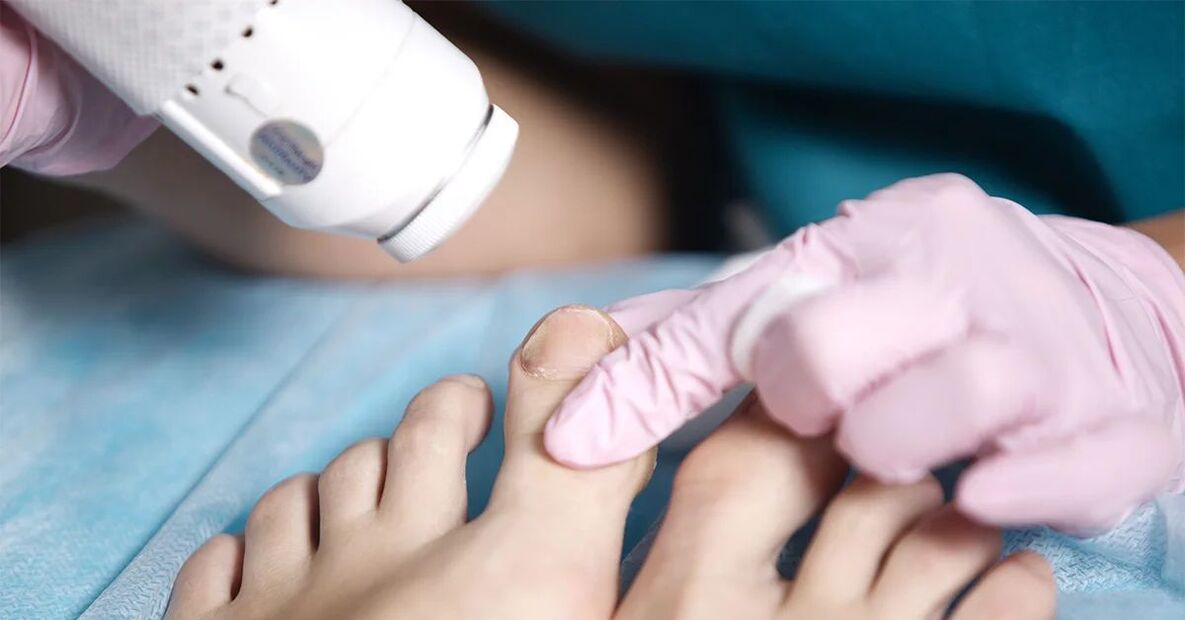
Drug therapy for onychomycosis
The specialist prescribes treatment at the initial stage of nail fungus, taking into account certain factors:
- degree of plate change;
- stages of hyperkeratosis;
- damage area;
- Clinical form of pathology.
At the beginning of the development of the disease, the dermatologist prescribes local remedies. These include ointments, varnishes, solutions and creams with antifungal properties (antifungal). It is recommended to use it after treating an infected nail. Preparatory measures improve the access of drugs to the inside of the plate and thereby accelerate fungal therapy.
To soften the nail, you can use patches containing urea or salicylic acid:
- Carefully process the nail plate with a nail file;
- Apply an antifungal medication;
- Cover the nail with a bandage;
- Remove it after a day;
- Use an antifungal medication prescribed by a dermatologist.
The specialist usually only prescribes medication for external use.
Attention!
Antifungal systemic agents are not used for onychomycosis in the initial stages of development.
Treating nail fungus at home
In the initial stages of the disease, you can try proven folk remedies at home.
- Apple Cider Vinegar . Simply soak your feet in a 1: 1 mixture of apple cider vinegar and warm water for about 15-20 minutes 1-2 times a day. After soaking, let your toenails dry completely (you can use a hair dryer). And within about two weeks, you will notice that the fungus disappears and a beautiful new nail grows in the place of the old, damaged nail.
- Tea tree oil should be applied to fungal skin and nails three times a day. A single dose is 4 to 10 drops of the product. This treatment should be continued for at least two weeks or even longer to ensure that the infection does not reoccur. This oil should not be used by children or pregnant women.
- Freshly picked celandine is passed through a meat grinder and the juice is squeezed out of the resulting pulp (this is done through 3-4 layers of gauze). It should make about 200 ml. JuiceIt is combined with 200 ml. Add 70% alcohol and let sit for 24 hours. The prepared juice is used to lubricate the affected nails, but the treatment is carried out only after the feet have been steamed for 10 minutes and completely dried. The treatment duration is 10-12 days, 3-4 treatments per day.
- Another way to eliminate nail fungus is to treat it at home with iodine. It's very easy. The nail plate is moistened with iodine every day for three weeks. In this case, the growing tip of the damaged nail is regularly removed.
- Kombucha also helps fight fungus. For this treatment, compresses are made: wrap a plate of kombucha in cellophane, wrap a bandage around your leg, and then put on socks. In the morning you need to wash your feet with warm water, carefully remove dead areas and lubricate them with iodine. Although the side effects include quite severe pain, you can achieve the desired result much faster.
If folk remedies do not give the desired result, you should contact specialists to prescribe complex therapy.
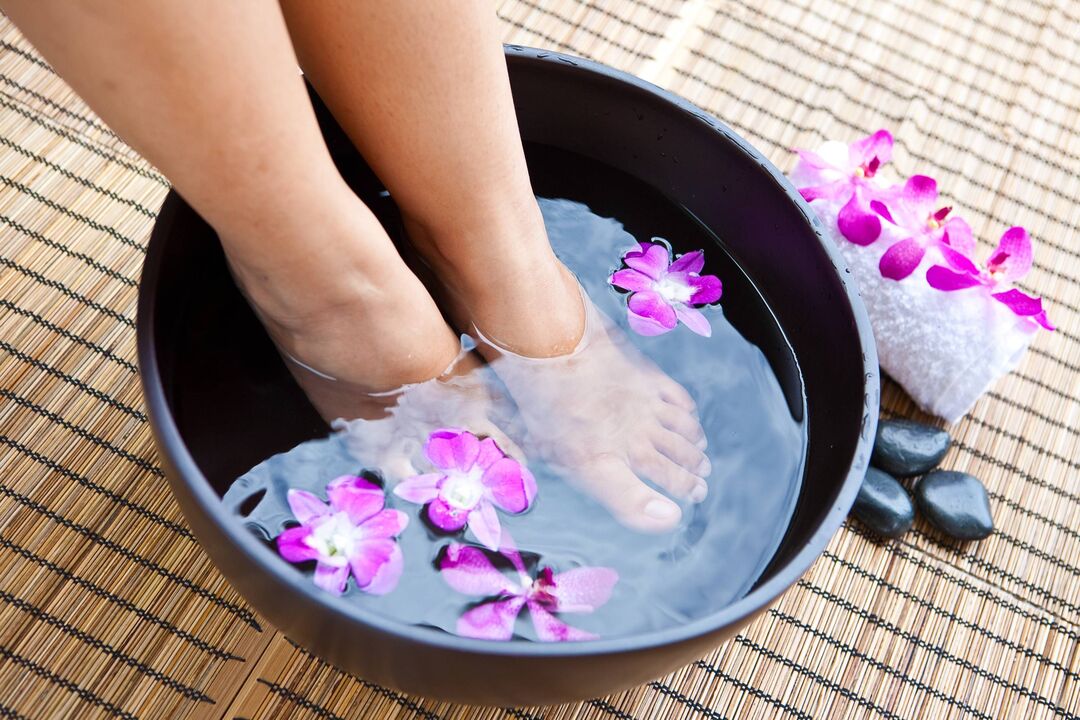
Infection with pathogenic fungi occurs both through contact and through poor hygiene. Onychomycosis (nail plate fungus) is most often transmitted through the use of common shoes in everyday life, in gyms and other places with high humidity and temperature. The initial stage of toenail fungus has certain signs. Knowing them, it is possible to avoid the transition of pathology to another stage of development.
All folk remedies can only be used after consulting a dermatologist. Many of them can cause allergic reactions. It is easier to cure onychomycosis by combining alternative remedies with medications.
In the initial stages, toenail fungus appears in the form of barely noticeable grooves or white spots. Often you only find out that you have a fungal infection when you visit your dermatologist. This is because during this period it is almost impossible to detect the disease itself. If therapy is started in a timely manner, the disease can be cured quickly.
Fungi (onychomycosis) is not just a dermatological disease; In advanced forms, many systems and internal organs are affected. To promptly stop the pathology, you need to know the symptoms and methods of treatment. How does the disease manifest itself in different stages? Which medications are most effective?
You can become infected with a fungus at home if someone in your household has it; everyone uses the same pedicure or manicure set. But the risk of infection is significantly higher in public places - the fungus lives in bathhouses, swimming pools and showers in fitness centers.
What diseases can cause a fungal infection:
- Flat feet, congenital or acquired foot deformity;
- poor blood circulation in the lower extremities;
- increased sweating of the feet;
- corns, excessively rough skin on feet;
- frequent injuries to the nail plate;
- weakened immunity, chronic diseases, diabetes.
Fungus on the feet often develops in lovers of tight shoes and people who neglect the rules of personal hygiene. Infections often occur in beauty salons where the instruments are poorly made. The disease can be provoked by taking oral contraceptives and antibacterial drugs.
Precautions
To avoid the disease it is necessary:
- Avoid direct contact with fungal vectors.
- Observe the rules of personal hygiene and wash your hands after visiting public places.
- After washing, carefully wipe the areas between your fingers as the fungus loves a warm and moist environment.
- Do not use other people's shoes and household items.
- Wear socks made from natural fabrics.
- Wear shoes in a public pool, bathhouse or sauna.
- Use personal manicure accessories.
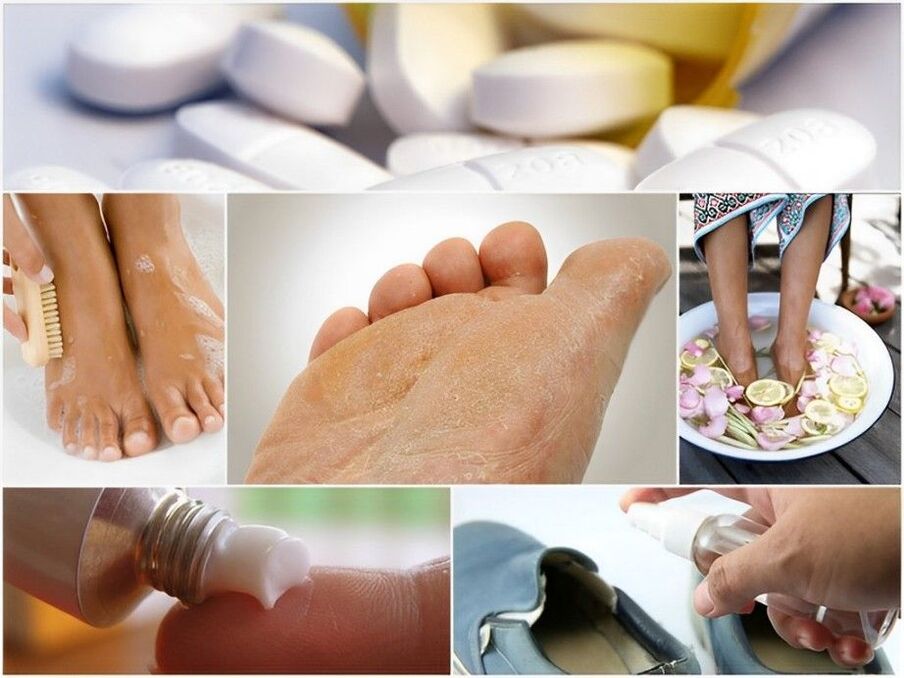
forecast
The prognosis with timely diagnosis and adequate treatment of nail fungus is favorable. Against the background of accompanying chronic diseases, the prognosis worsens.
Treatment for advanced nail fungus is long-term. Relapses occur in 40-70% of cases.


















